
At the end of every round, a boxer returns to their corner for one minute of respite from the physical and mental punishment they are facing in the ring.
They sit on the stool, breathe in and potentially place their career in the skilled hands of the cutman – a crucial member of the corner team whose job it is to repair wounds and keep their man in the fight.
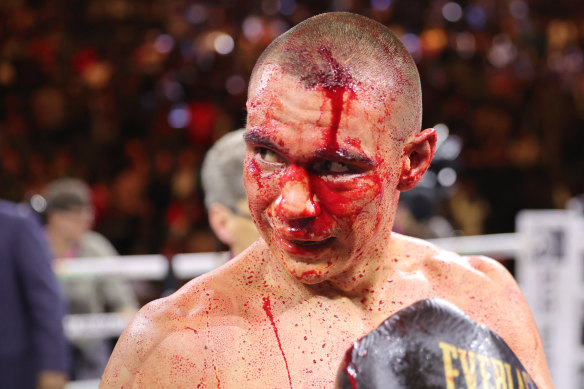
Tim Tszyu at the end of the fight against Sebastian Fundora.Credit: Getty
If the cutman does his job well, the boxer will have the chance to win the fight and unlock untold fame or fortune. But if they fail, they are often saddled – fairly or unfairly – with the blame, making the job of the cutman one of the toughest in sport.
Angelo Hyder spent four years in the Australian Army as a medic before taking up boxing training. He never had a particular desire to be a cutman, but learned the art from an Australian master of the craft, Brian Willmott.
Willmott would carefully treat his fighters’ cuts between rounds and like a chief surgeon calmly instructing an intern, he’d talk the ex-serviceman through exactly what he was doing, how much pressure to apply and what tools to use. Hyder had a knack for picking up the work quickly and refined his craft over thousands of rounds with all types of fighters, working on all types of cuts.
“I’d turn up to an event and would do all the opponents as well,” Hyder said. “I learned so much from a Russian opponent one day. It was full arterial bleeding – it was spurting out the top of his head.
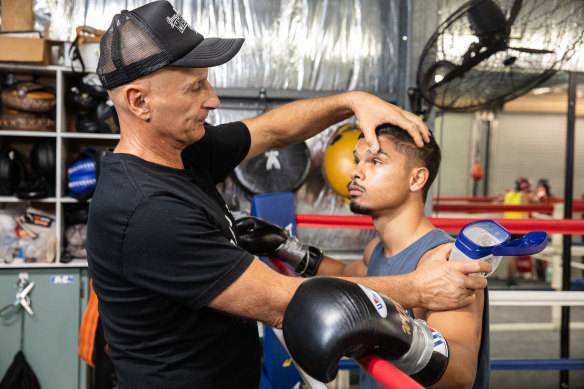
Boxing cut man Angelo Hyder in his gym in Kingscliff, NSW where he also trains world champions Jason and Andrew Moloney. Credit: Natalie Grono
“I had to work on that for three rounds until I learned how to stop it with how much pressure I could put on it. With every cut you treat, you learn more and more.”
In the army, Hyder had learned the importance of keeping soldiers calm when tending to gunshot wounds. His ability to work quickly under immense pressure is a skill he took into the fight game. With just a minute at his disposal, Hyder wants to put his fighter at ease and keep them confident that they can win the bout as long as he is in their corner.
“You’re just trying to keep them calm, you’re saying, ‘Just breathe, I got this under control, just relax’,” Hyder said. “A lot of the time they’re pushing away from me because I’m putting a huge amount of direct pressure on these cuts.
“When a guy has a bad cut, the cutman needs to take over. The trainers gotta get out of your way and when the bell goes [to end the round], I’m like a greyhound, I’m through those ropes.”
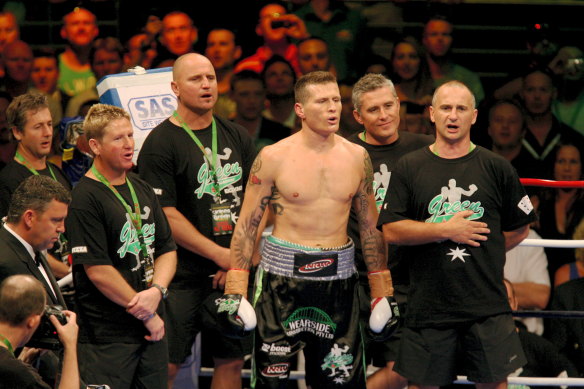
Hyder, on far right, with Danny Green before a fight.Credit: Digicam
Hyder went on to work with some of Australia’s greatest boxers, including Danny Green. He currently trains world champions Jason and Andrew Moloney at his gym in Kingscliff in northern NSW.
Working for Green during a fight in Perth before a big local crowd, Argentine opponent Jorge Sclarandi sustained a deep gash in the first round that threatened to end the bout. Sclarandi had travelled to Australia with no cutman – so after conferring with Green, Hyder sprinted over to repair his opponent and keep him in the fight.
“I think it was the second pay-per-view ever we did in Perth,” Hyder said. “The referee was just soaked blood red. To his credit, he knew it wasn’t hurting the guy, and he wasn’t going to stop it in the first round or else [the fans] were going to tear the stadium down.
“He let it go on until I could get over in that corner and stop the bleeding. The opponent was trying to do it himself, and it just was too big for him. I jumped in there and I treated it straight away and got him through until Danny ended up stopping him in the fifth round.”
‘Trust is everything in boxing’
Legendary trainer Johnny Lewis started learning his trade as an 18-year-old at Newtown PCYC, making a quick study of his boxers throughout their fights, coming to know exactly when they needed a calm word in their ear and strong pressure on a tricky cut that wouldn’t stop bleeding.
The intricate relationship between the cutman and the boxer starts long before fight night. Lewis, who guided Australian world champions Jeff Fenech, Kostya Tszyu and Jeff Harding, understood that trust is built slowly over time, initially in the gym. It is a relationship that becomes almost telepathic, so that the cutman can instantly recognise when their fighter is in danger by something as small as their level of eye contact between rounds.
“It’s a love affair that definitely comes with love and respect for your fighter, trust is everything in boxing,” Lewis said.
“You’ve got to first and foremost remember that you’re in control of this fight as well, there are some fighters that love to be screamed at, but for me, I always wanted to show absolutely no panic, so they can go out for the next round, the next round after that and keep going through the fight.”
Lewis dealt with cuts big and small throughout his career, but few held the significance of a wound over the right eye of Jeff Harding as he challenged WBC light heavyweight champion Dennis Andries as a late replacement in 1989. Harding travelled from Sydney to the glitzy surrounds of Trump Plaza Convention Centre in Atlantic City, with few people giving him a chance of winning the title.
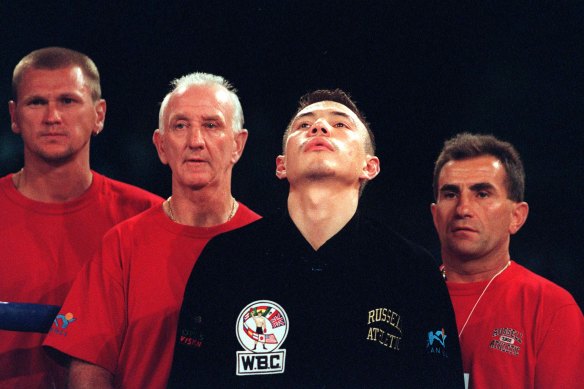
Johnny Lewis, second from left, with Kostya Tszyu before a contest.Credit: Tim Clayton
Harding’s cut opened up at the end of the first round and Lewis knew he had to not only keep his fighter calm, but also keep the gash under control otherwise the fight was likely to be stopped. Lewis kept the cut sealed and Harding stopped Andries in the final round, creating one of the most memorable moments in Australian boxing.
“It was a bad cut and it happened very early, but we always knew that we could fix it up,” Lewis said. “Jeff was totally in control, even though the eye opened right at the end of the fight. It came down to experience, dedication, and above all things, always knowing the key thing: that the fighter is always the most important person in the equation.”
‘That cut was like something I’ve never seen’
In his previous 100 fights as a cutman, Mark Gambin never chased the spotlight. He always wore a black cap and hung at the back of the victory photos of the fighters he had tended – including his most famous client, Tim Tszyu, with whom he had worked for every one of his previous 24 victories.
Gambin understood that his job was to be in the background, but when called into action he was there to keep his boxer in the fight. At the end of the second round against Sebastian Fundora in Las Vegas in March, after a comfortable start, Tszyu ducked into a stray elbow, opening up a deep wound that would change his career – and that of Gambin.
Two months after the fight, the cut still hasn’t fully healed and on Friday, it forced Tszyu to withdraw from his proposed comeback bout against Vergil Ortiz Jnr in Los Angeles on August 4 on medical grounds. Shortly after the loss to Fundora, Gambin spoke about the severity of the cut and his challenges dealing with it.
“I’ve never ever, bar last weekend (against Fundora), ever been bothered with a cut, but it’s just mind-boggling, and it was frustrating for me because I couldn’t stop it,” Gambin said. “I tried everything I did over years. Tim was cut twice in Minnesota [against Terrell Gausha] and I stopped them both.
“After that fight, everyone’s coming up and give me big raps, but in this fight [against Fundora] I’m the worst man in the world. It’s a results-driven sport I suppose, and you live and die by the sword, but the cut was like something I’ve never seen in boxing.”
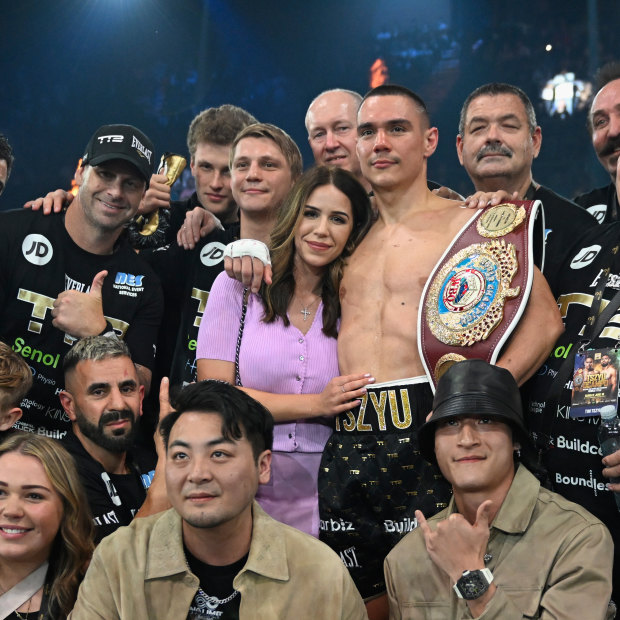
Tszyu v Ocampo at the Gold Coast Convention Centre in 2023. Mark Gambin gives the thumbs-up after victory.Credit: Matt Roberts
Gambin takes meticulous care of the tools of his trade which he carries to stem cuts, including and not limited to vaseline, adrenaline Q-tips, gauze, ice bags and a flat rectangular metal tool called an enswell to reduce swelling around the eyes.
For most of the second round against Fundora in Vegas, Tszyu was so in control that Gambin started to get his medical bag in order, confident his fighter was going to get a knockout soon.
“After a win, everyone jumps around and I don’t like losing my stuff,” Gambin said. “I thought Tim was all over him. He was landing the cleaner shots and Fundora didn’t want to be there any more.
Loading
“I could see it, I could hear his whimpering and then [Tim] just ducked in and under and it was like a razor blade, I think it turned everything.”
Tszyu returned to the corner with his body covered in blood and it quickly dawned on Gambin that the wound on the top of his fighter’s head was like nothing he had ever dealt with before, either as a cutman in boxing or during his time in rugby league working for the Cronulla Sharks. The cut was so deep Gambin described it as a “hose” that would not stop flowing, regardless of the pressure he applied.
“I was doing everything I needed to do and like I’ve done for 24 fights for Tim but it was just one cut that wasn’t going to be beatable, I think,” Gambin said. “There’s another thing, too, he got 12 stitches [after the fight] and it was still bleeding in the press conference.”
It is rare that a cutman gains plaudits for their skill in stemming a deep wound. The credit rightfully goes to the fighter. However, when a cutman fails to get a cut under control, the spotlight on their actions is relentless. In the aftermath of the loss to Fundora, Tszyu’s corner was criticised for not asking the referee to stop the fight. But Gambin is clear that call is the responsibility of the referee.
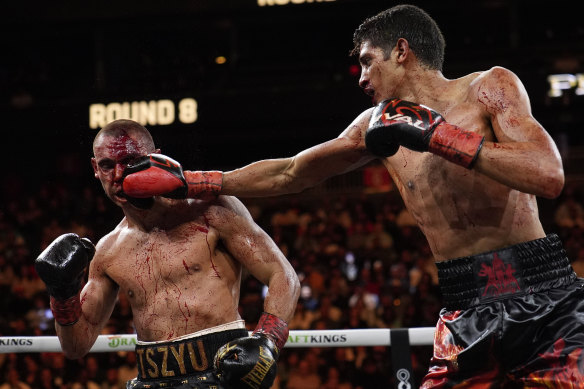
Against Fundora, Tszyu was blinded by a flow of blood Gambin simply could not stem.Credit: AP
“My job is to [stop] that blood flowing and assist Tim in every way I can. It’s the officials [that] call it,” he says. “They have to make a decision and they didn’t make a decision.
“So we, you know, we’ve been a little bit hammered about that [decision not to stop the fight], myself and Igor [Goloubev], but it comes down to officials. They’ve got to have a good look at it themselves. They could see Tim was struggling with his vision.”
Gambin admits that the fallout from Tszyu’s first loss has taken a toll on him personally, given his love of the sport and the fighters he prides himself on looking after.
“I was pretty upset, I was pretty flat at myself, and I was kicking buckets to be honest,” Gambin said. “I take it personally, that’s my job and I’ve always taken I’ve taken a lot of pride and I used to actually enjoy someone getting cuts, like ‘good there’s something to do’.
Loading
“I’ve always stopped them, but this one beat me and I’ve never been beaten by a cut, so I was pretty flat and felt pretty shithouse and then had to get a flight home [to Sydney] for 14 hours.
“There were boxing web pages, everyone was just giving it to the corner and giving it personally towards me, and my family had to sort of see a little bit of that, so I got rid of Facebook for a couple of days and I just had to get off at me because so many experts, they just weren’t there.
“I struggle, I still have days where I’d love to go back to that moment and just try again. You know, I do everything I can for Timmy. You know what I mean? To give him that vision for a minute or so that would been awesome.”
Sports news, results and expert commentary. Sign up for our Sport newsletter.



























